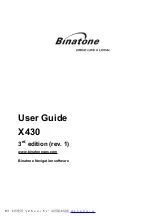
the angle of incidence on the solar panels increases, it will take longer to reach the point where
there is sufficient power for the High Power mode. Similarly in the evening, the U4B will stop
working sooner. If you are really clever, you can measure the battery voltage and use BASIC
commands to choose between low and high power modes.
4.2 Variables
There are 26 general purpose variables, they are named A, B, C and through to Z. Each variable
is a 32-bit unsigned integer.
There are also some system variables, with two-character uppercase variable names as listed
below:
Name
Writable
Contents
AT
No
GPS Altitude (meters)
BT
No
Battery voltage (millivolts)
CL
No
GPS calibration completed successfully: 1, otherwise 0 if not
FS
Yes
System frequency (Hz), nominally 8 MHz
FQ
No
Transmitter frequency (Hz)
FR
Yes
PLL Reference frequency (Hz), nominally 25 MHz
GL
No
GPS 3D satellite lock acquired: 1, otherwise 0 if not
GS
No
GPS Speed (knots)
GV
No
GPS Validity bit: 1 for “A” flag, 0 for “V” flag
HP
Yes
Transmitter High Power mode: 1 = High power, 0 = Low power
SD
No
Realtime clock Date has been set (by GPS): 1, otherwise 0 if not
ST
No
Realtime clock Time has been set (by GPS): 1, otherwise 0 if not
TK
No
Onboard temperature sensor reading now (Kelvin)
TT
Yes
Temperature reading transmitted in telemetry (Kelvin)
US
No
USB host connected: 1m otherwise 0 if not
Many of these variables are read-only (as indicated in the table above). All general purpose
variables A to Z are read/write.
Variables may be set by the command syntax:
LET <variable> = <expression>
Examples:
LET A = 4
LET B = TK
LET C = D * (E + 2)
Variables may also be inserted into strings by using the # tag followed by the two letter variable
name; the general purpose variables are referred to in this way using tags #VA to #VZ.
For example:
PRINT TK
PRINT “#TK”
U4B operating manual Rev 1.00
24
Содержание U4B Ultimate4
Страница 54: ...U4B operating manual Rev 1 00 54...















































